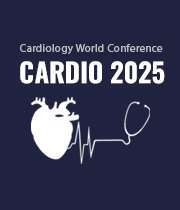Title : ‘From rupture to repair’ - A Successful device closure of LA rupture during BMV - A life-saving intervention
Abstract:
We describe a case of Left Atrium (LA) rupture during BMV with an Accura Balloon, leading to cardiac tamponade, which was successfully managed by percutaneous device closure followed by a successful BMV.
Case Presentation: A 52-year-old female with a known case of RHD presented with chief complaints of dyspnea. Trans-Thoracic Echo (TTE) suggested RHD with severe MS. The patient was planned for elective BMV. The transseptal puncture was performed using standard fluoroscopic landmarks. The septal puncture was dilated with a transseptal dilator. Using an Accura balloon (number 25), the first inflation was attempted, yielding suboptimal results. Hence, a second inflation was performed. While maneuvering the balloon inside the LA to pass it into the LV, the patient developed sudden hypotension, bradycardia, and syncope. TTE showed pericardial effusion with tamponade physiology. Immediate pericardiocentesis was performed, and auto-transfusion was initiated.
During fluoroscopy, the balloon was observed to be within the cardiac shadow, ruling out pulmonary vein rupture. Additionally, no ventricular premature contractions were detected on ECG, indicating that the balloon had ruptured the LA and was likely positioned in the pericardial cavity. Subsequently, a diagnostic fluoroscopic image, obtained by injecting contrast through the Accura Balloon, revealed active contrast leakage into the pericardial space through the LA free wall rupture site. Consequently, we decided to promptly close the rupture site using a device.
An Amplatzer super-stiff wire was introduced through the Accura Balloon into the pericardial space via the defect in the LA. A Life tech Konar MF VSD device (12/10 mm) was passed over the Amplatzer super-stiff wire. One rim of the device was deployed in the pericardial space and gradually pulled inside the LA. As the outer rim of the device anchored at the LA defect on the pericardial side, the other rim was opened in the LA. As no contrast leakage into the pericardial space was observed upon injecting contrast into the LA, the device was released. A second inflation of BMV was then performed using the Accura balloon (25) with excellent results. The patient was discharged on tablet Ecosprin 150 mg OD and has been doing well for the past seven months.
Conclusion: There are no reported cases in the literature of percutaneous closure of an LA rupture using a device. Current treatment modalities involve open thoracotomy and surgical repair of the injury site. Our case may be the first reported instance of successful percutaneous intervention for LA rupture causing tamponade during BMV. This case highlights that such ruptures during BMV/TMVR/TEER can be effectively managed using a percutaneous approach with an appropriately sized VSD device. Considering the diameter of the Accura balloon (14F~5 mm), devices with two rims and a waist diameter of approximately 7 mm are adequate for sealing such defects. We emphasize the importance of keeping such devices readily available in catheterization labs where structural interventions of the mitral valve are routinely performed.



